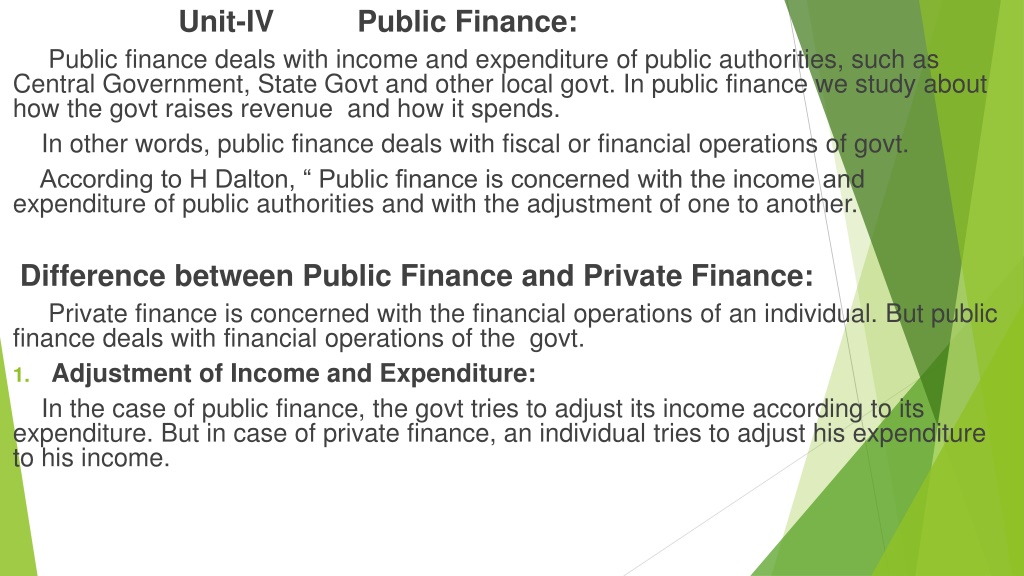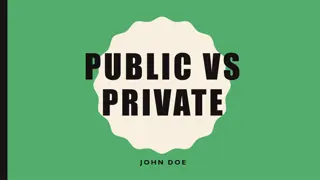Contrasting Public Finance and Private Finance
Public finance involves the income and expenditure of governmental bodies, focusing on societal welfare, compulsory nature, coercive revenue collection, and long-term welfare objectives. In contrast, private finance pertains to individual financial operations, voluntary nature, income adjustments to expenditure, and short-term considerations. Key differences include the compulsory character, motives, budget nature, resource availability, and expenditure patterns between public and private finance.
Download Presentation

Please find below an Image/Link to download the presentation.
The content on the website is provided AS IS for your information and personal use only. It may not be sold, licensed, or shared on other websites without obtaining consent from the author.If you encounter any issues during the download, it is possible that the publisher has removed the file from their server.
You are allowed to download the files provided on this website for personal or commercial use, subject to the condition that they are used lawfully. All files are the property of their respective owners.
The content on the website is provided AS IS for your information and personal use only. It may not be sold, licensed, or shared on other websites without obtaining consent from the author.
E N D
Presentation Transcript
Unit-IV Public Finance: Public finance deals with income and expenditure of public authorities, such as Central Government, State Govt and other local govt. In public finance we study about how the govt raises revenue and how it spends. In other words, public finance deals with fiscal or financial operations of govt. According to H Dalton, Public finance is concerned with the income and expenditure of public authorities and with the adjustment of one to another. Difference between Public Finance and Private Finance: Private finance is concerned with the financial operations of an individual. But public finance deals with financial operations of the govt. 1. Adjustment of Income and Expenditure: In the case of public finance, the govt tries to adjust its income according to its expenditure. But in case of private finance, an individual tries to adjust his expenditure to his income.
2. Compulsory Character: Public finance is known for its compulsory character. The govt cannot avoid or postpone certain expenditure, like defence, administration, maintenance of law and order etc. But private finance is voluntary in nature and plan to postpone their expenditure. 3. Coercive methods: The government can use coercive methods to collect revenue. For eg: it can impose taxes- If a person fails to pay taxes, force can be used by the government. However, individual cannot use force to get their income, they have to earn their income through their own efforts. 4. Impact on society: Public finance aims at welfare of all the people. So, it has a greater influence an the society. But Private finance aims at personal welfare. So, it has less impact on the society.
5. Difference in motives or objectives: The objective of public finance is public welfare or social welfare. On the other hand, private finance aims at individual welfare. 6. Nature of budget: The government generally prefers a deficits budget, that is, spending more than its income. On the other hand private finance believes in having a surplus budget that is, spending less than its income. 7. Nature of resource: The sources of raising resources of the public authorities are enormous. But the sources of resources to an individual are limited. 8. Pattern of expenditure: The public expenditure is governed by a deliberate economic policy of the government. The economic, social and political requirements of the country are considered while planning the public expenditure. The pattern of private expenditure is influenced by habits, customs, status and personal needs of the individuals.
9. Time duration: Public finance aims at maximising the welfare of both present as well as future generation. So, it has a long run perceptive. On the other hand, private finance aims at short run consideration. The individual satisfies his present needs & he is interested in getting quick returns. ***************************
Components of Public Finance: 1. Public Revenue: The income of the government through all sources is known as public revenue. It studies the methods of raising revenue and principles which should govern public revenue. It also studies the classification of taxes, canons of taxation, effects of taxes, etc. 2. Public Expenditure: It refers to the expenditure incurred by the public authorities. It studies the classification of public expenditure, effects of public expenditure, public expenditure policies of the government, etc. 3. Public Debt: It refers to the loans raised by the government internally and externally. It studies the need for and methods of raising public debt. It also studies the problems related to raising and repayment of public debt.
4. Financial Administration: It refers to the study of the different aspects of public budget. The objective of framing budget, the methods of framing it, sanctioning and audit, etc are studied in this component. 5. Economic Stabilisation: It studies the use of public revenue and expenditure to secure economic stability and growth. It includes the various economic policies and measures of the government that are used to achieve full employment, balanced growth and optimum use of resources.
Principle of Maximum Social Advantage: It is the most fundamental principle of public finance. This principle was introduced by British economist H Dalton. This principle is explained by Dalton by using the two fiscal tools such as tax and public expenditure. When tax is imposed, some disutility is created. On other hand when govt spends money the society enjoy certain amount of utility. According to this principle, public expenditure and taxation are carried out up to that point where the marginal utility of public expenditure is equal to the marginal disutility or the sacrifice imposed by taxation. The point of maximum social advantage can be determined by the equality between marginal social benefit and marginal social sacrifice.
Dalton explained the concept of maximum social advantage with reference to Marginal Social Sacrifice and Marginal Social Benefits. Marginal Social Sacrifice ( MSS ) It refers to the amount of social sacrifice undertaken by the public due to the imposition of an additional unit of tax. Every unit of tax imposed by the government results in loss of utility. Hence, the marginal social sacrifice goes on increasing. Marginal Social Benefit ( MSB) The benefit derived by the society due to an additional unit of public expenditure is known as Marginal Social Benefit. The social benefit from each additional unit of public expenditure declines as more and more units of public expenditure are spent. Hence, the marginal social benefit goes on diminishing. The principle of maximum social advantage is explained with the help of following diagram.
Y MSS B1 M2 MSB And MSS M1 S E M MSB B S1 X O Q Q2 Q1 Unit of taxation and expenditure
In the above diagram, MSS is marginal social sacrifice curve. It is an upward sloping curve from left to right indicates that the social sacrifice per unit of taxation goes on increasing with every additional unit of money raised. MSB is a marginal social benefit curve is a downward sloping indicates social benefits per unit diminishes as the public expenditure increases. The MSS curve and MSB curve intersect at the point E which represents the optimum level of government s financial activity. At this point, government expenditure becomes equal to government revenue as shown by OM. Further, MSS( Marginal Social Sacrifice ) is equal to MSB ( Marginal Social Benefit) as shown by OQ.
Tests of Social Advantage: Prof. Dalton has given following objective tests which can lead to maximum social advantage. 1. Protection of the Community: The first test is for the preservation of the community against external attack and internal disorder. For this reason large amount of money spent on armed forces, police and judiciary are quite justifiable. 2. Increase in Employment: The operation of public finance is desirable if they lead to an increase in employment of resources. This should aim at improving the level of production and volume of national income. 3. Reduction in Economic Inequalities: The public finance operations should bring about greater equality in the distribution of income and wealth.
4. Economic Stability: The public finance operations of the govt are desirable if they are maintaining economic stability in a country. 5. Provision for Future Generation: The financial operations of the state are desirable if they look after welfare of the present as well as future generations. Limitations: 1. Non-Measurability of social sacrifice and social benefits: There is no effective means to measure the disutility of taxation and the utility conferred by public expenditure quantitatively. 2. Non applicability to public borrowings: Loans raised from the public involve no social sacrifice because such loans are repayable with interest after a certain period of time.
3. Misuse of govt funds: A large share of government funds is misused for unproductive purposes which do not provide any social benefit. 4. Neglect Non-tax revenue: Dalton fails to take into account non tax revenue sources like public borrowing, profits from public enterprises, fees, penalties etc. 5. Lack of divisibility: In order to equate the marginal benefit from public expenditure with the marginal sacrifice from taxation, the resources are required to be divided into smaller units. But it is not possible because of lack of divisibility of public expenditure and taxes in small units.
Public Revenue: The income earned by the govt through all its sources is called public revenue or public income. Prof. Dalton has defined public income in a narrow and a wider sense, in terms of public revenue and public receipts. In the narrow sense, Public revenue is not subject repayment, it includes revenue from taxes, fees, fines, prices, etc. But in the wider sense, public receipts includes income from all the sources, it also includes loans raised by the govt which are subject repayment. Sources of Revenue: The sources of public revenue may be broadly divided into two: I Tax revenue and II Non tax Revenue
I. Tax Revenue: Taxes are compulsory contribution to the govt by the citizen of the country without any special benefit in return. The tax revenue is derived from the following sources. a. Taxes on income and expenditure such as income tax, corporate tax, expenditure tax, interest tax, etc. b. Taxes on commodity and services such as GST, excise duties, sales tax, custom duties, service tax, value added tax. c. Taxes on property and capital transactions like wealth tax, gift tax, house tax, estate duty, etc II. Non-Tax revenue: The revenue earned by the govt other than tax is called non tax revenue. It includes,
I. Administrative Revenues: It refers to income received by the government from its day today administrative activities. They are, a. Fees: Fees is the amount charged by the govt on its citizens for certain special services. Eg: court fees, education fees, medical fees etc. b. License fee License fees are charged by the govt to give permission to undertake certain activities. It includes driving license fee, passport fee, registration fee etc. c. Special assessment: The payment made by the citizens of a particular locality in exchange for certain special facilities given to them by the public authorities is known as special assessment. For instance irrigation project, well means of transport etc.
d. Fines and penalties: The govt also imposes fines and penalties on those people who violate the law of the country. The ultimate objective of imposing fine is only a corrective and not revenue realising measure. e. Forfeitures: It refers to the penalties imposed by the courts for the failure of individuals to appear before the courts to complete contracts as stipulated. f. Escheat: It refers to the properties and other kinds of assets of people who die without any legal heirs or without having a will. It includes bank balances, properties of individuals, trusts, institutions. 2. Commercial Revenues: Govt own and manage commercial and industrial enterprises such as railways, post and telegraph, state trading corporations, modes transport, financial institutions, etc. The revenue earned by these public enterprises by selling goods and services to the citizens is known as commercial revenues.
3. Other Revenues: a. Gifts, Grants and Donations. Sometimes the government may also earn some income in the form of gifts, grants and donations offered to it by the citizens, institutions and even foreign governments and international institutions for various purposes. b. Government Properties: The government also earn some income from public properties like land, buildings, mines, forests, fisheries, etc. c. Public Borrowings: Public authorities borrow from various sources both internally and externally, that will be repaid at a future date. d. Tributes and Indemnities: Some governments get extraordinary revenue in the form of tributes and indemnities. Foreign countries pay tributes. Indemnities are paid in case of damage to a country either by war or aggression.
e. Recovery of loans: Governments may get revenue by way of recovery of loans due from debtors to it. f. Miscellaneous Sources: A Government may also get some amount of revenue from lotteries, auctioning of confiscated goods, printing of currency notes, interest income earned on loans granted. ********* ********* *********
The Canons of Taxation: The characteristics or qualities which a good tax should posses are called as canons of taxation. In other words, it refers to the principles followed by the govt while imposing taxes on the people. Adam smith was the first economist who gave 4 basic principles of taxation. Later, C.F Bastable have developed their own canons of taxation. 1. Canon of Equality: This canon is also called ability to pay. This means that taxation should be imposed on the people according to their capacity to pay taxes. 2. Canon of Certainty: It means that tax payer should know the amount of payment, the method of payment, the place and the time of payment. 3. Canon of Convenience: According to Adam Smith, every tax should be levied in such a manner and at such a time in which it is more convenient for the tax payer.
4. Canon of Economy: The tax system should be economical. It means the minimisation of the cost of collection. The cost of collection of tax should not be more than the revenue. 5. Canon of Productivity: According to this canon, a tax should be yield sufficient income to the government. It should b possible for the govt to rise adequate resources from taxes. 6. Canon of Elasticity: It implies that it should be possible for the govt to effect necessary changes in the tax system. Elasticity means the tax rates should be capable of earning more revenue on the basis of fiscal requirements. 7. Canon of Simplicity: It means that the tax system should be easy for the people to understand and interpret the rules and regulations. It should not be complicated.
8. Canon of Diversity: The tax system should consist of a variety of taxes. There must be fair number of taxes producing the required amount of revenue. 9. Canon of Expediency: According to this canon the tax should be based on certain well founded principles. So that it may need no justification from the govt side. In other words, the taxpayers should have no doubt about its desirability.
Public Expenditure: The expenditure incurred by public authorities such as central, state and other local governments either for protecting the citizens or for promoting their economic and social welfare. It is a instrument of fiscal policy to maintain economic stability. Heads of Public Expenditure: Public expenditure may be broadly classified under the following heads: A. Revenue Expenditure: It refers to the expenditure incurred by the government for day to day administration. It is met out of current revenue. Revenue expenditure is further classified into: 1. Civil Expenditure: It refers to the expenditure of the government to maintain justice, law and order. It includes:
a. Expenditure on general services. It involves expenditure on parliament, legislature, maintenance of embassies, government departments, police force, law courts, jails as well as expenditure on salaries and allowances of govt employees, ministers and legislators. b. Expenditure on Social services: It refers to the expenditure of the government on social and welfare activities like education, health, housing, medical facilities, sanitation and various social security measures. c. Expenditure on Economic services: It is the expenditure incurred on the development of economic activities such as the promotion of industries, agriculture, transport, trade, communication, irrigation, power, banking, etc d. Expenditure on public debt services: It includes the interest payments on public debt and repayment of public debt.
2. Defence Expenditure: This includes the expenditure on defence forces, production of arms and ammunition, pensions to retired defence personnel. etc. 3. Grants-in-Aid to other Governments: It consists of financial assistance given by the central government to other governments. In India, Central Govt gives financial grants to States and union territories for financing their economic projects. 4. Miscellaneous Expenditure: It includes the expenditure of the government in providing subsidies to industrialists, exporters, relief rehabilitation of the people in times of natural calamities, etc. B. Capital Expenditure: It refers to the expenditure incurred on creating permanent revenue yielding assets. It includes.
1. Developmental Capital Expenditure: This includes expenditure incurred on development of agriculture, industry, minerals, power generation, transport and communication, public health, water supply, research and development. 2. Non-Development capital expenditure: This consists of expenditure on defence expenditure incurred on creating capital assets for the defence sector, subsidies, etc. 3. Repayment of Public Debt: This includes the repayment of permanent debt. 4. Loans and Advances to other Governments: In India, it includes loans and advances to states and union territories.
Since 1987-88 onwards the Central Govt of India adopted a new classification of public expenditure. It includes 1. Plan Expenditure: It refers to those expenditures which contributes to the economic development of the country. It is divided into 3 sub heads. a. Economic Services: These contributes directly to the economic development of the country. They include expenditure on agriculture, industries, minerals, mining, transport etc. b. Social and Community Services: It helps in building up of the productive capacity and efficiency of the people . They include expenditure on education, training and skill formation, research and development, science and technology, arts and culture etc. c. Grants-in-aid to States and Union Territories and Foreign Governments: It includes developmental grants given by the central government to States and union territories.
2. Non-Plan Expenditure: This expenditure do not contribute directly for the development of an economy, but essential for carrying on day to day activities of the state. a. Interest payments and debt servicing charges. b. Defence expenditure. c. General Services. d. Subsidies. e. Expenditure on police etc.
Public Debt: It refers to the loans raised by the govt from the central bank, commercial banks, business organisations and individuals. It includes borrowing by the central govt, state govt and local authorities. Public debt is one of the important tool of fiscal policy. Public debt is generally in the form of issuing bonds and treasury bills. Differences between public debt and private debt: 1. The govt has vast sources of borrowing. It can borrow from the sources inside the country as well as from external sources. An individual has limited sources. An individual cannot borrow easily from external sources. 2. The government can use force and compel the people to lend money. An individual cannot use force and compel other individuals to lend them. 3. The govt can take loans for a longer period. 3. Individual normally takes loans for a shorter period.
4. Govt loans are generally spent on productive purposes. Individuals may borrow for productive, non productive and consumption purposes. 5. The rate of interest on govt loans is normally lower than the rate of interest on private loans. Moreover, the govt can reduce the rate of interest unilaterally on public loans. Individual cannot lower the rate of interest on their loans. 6. In the case of internal public debt, the lender also shares the burden of the debt and makes a contribution for its repayment. An individual has to repay the loan from his own earnings or savings. 7. The govt can refuse to repay the loan taken from the public in some critical conditions. The private individual cannot refuse repayment of loans. 8. The govt can borrow very huge amount of loan at one instance. individuals normally do not borrow beyond a certain limit at one instance.
Sources of Public Debt: The various sources of public debt may be broadly classified into two types. 1. Internal Sources of Public Debt. Internal sources refers to the sources that exist within the political boundaries of a country. They include individuals, commercial banks, financial institutions, business firms and central bank. a. General Public: The govt borrow from the general public in the form of bonds, debentures, certificates or loans. They bear a fixed rate of interest and are repayable on due date. b. Commercial Banks: The commercial banks generally provide loans to the government by subscribing to its bonds and loans. c. Non- Banking Financial Institutions: The govt bonds are also purchased by non-banking financial institutions like insurance companies, investment trusts, mutual funds, saving banks etc.
d. Central Bank: The central bank is the main source of public debt. It purchases the bonds of the government and credit the money to the account of the government. II. External Sources: A nation can borrow money from foreigners, foreign institutions and organisations, foreign govts and world financial markets. a. International Financial Institutions: Various Financial Institutions like IBRD, IMF, IDA, IFC, etc give both short term and long term developmental loans. b. Foreign Governments: Many capital rich countries provide grants and loans to developing nations for developmental programmes. c. External Commercial Borrowings: In recent years many govts borrow from various international money and capital markets at the market rate of interests. They borrow from London Money Market, Hong Kong Money market, New York Money Market, Etc.
Types of Public Debt: 1. Internal and External public Debt: Internal debts are the loans raised by the government from within the country. It involves a mere transfer of funds from the people to the government. External debts are the loans raised outside the country. It is borrowed from foreign nationals, governments, international institutions, etc. The differences between internal public debt and external public debt. a. Internal public debt involves borrowing from within the country. External public debt involves borrowing from outside the country. b. Internal debt is borrowed in terms of domestic currency. External debt is borrowed in terms of foreign currency, c. Internal debt may be voluntary or compulsory. External debt is voluntary in nature.
d. Internal debt does not increase the availability of total resources within the country. External debt leads to a change in the availability of total resources within the country. e. Internal debt does not affect the productive capacity much as the funds remain within the country. External public debt leads to a change in the availability of total resources within the country. f. Internal public debt does not influence the domestic policies. External public debt influence the domestic policies. g. Internal public debt involves less burden of debt. External public debt involves more and real burden of debt.
2. Productive and Unproductive Debt The debt is said to be productive when it is utilized for productive purpose. Such as irrigation projects, construction of roads and railways etc. It will increase the revenue of the government and out of which the government can pay interest on the loan annually and the principle in the long run. An unproductive debt is one which does not add to the productive assets of the country. In other words unproductive debt is that debt, the proceed of which are spent on non income yielding purpose like war. 3. Redeemable and Irredeemable Debt On the basis maturity, public debt may be classified as redeemable or irredeemable debts. Loans which the government promises to pay at some future date are called redeemable debts. The loans for which no promise is made by the government regarding the exact date of maturity are irredeemable debts. The government pays only interest on such loans and the principle amount is never returned by the government.
4. Funded and Unfunded Debt This classification is made on the basis of the provision made for repayment of public debt. Funded debt is that public debt for the payment of which the government establishes a separate fund. It is also known as long term debt. Unfunded public debt is that debt for the repayment of which the government creates no separate fund. These loans are also known as short term loans. 5. Voluntary and compulsory debt On the basis of legal enforcement public debt may be classified in to voluntary debt or forced debt. When loans are subscribed by the public according to their ability, will and convenience such debt is know as voluntary debt. Ordinarily, public debt is voluntary debt, if the public is compelled to subscribe to the loan it is known as compulsory or forced debt.
6. Marketable and Non-marketable Debt On the basis of the negotiability of government bonds, public debt may and be classified as marketable and non marketable debt. Marketable debt is one in which the government securities are bought and sold in the open market. They are negotiable and tradable in the open market. The government securities which cannot be bought and sold or are not tradable in the open market are non- tradable public debt. 7. Short-Term, Medium term and Long-term Public Debt. According to the time duration of the borrowing, public debt can be classified in into short- term, Medium term and long term loans. Short term public debt matures within a period of three to nine months. They include treasury bills and loans from central bank. Medium term loans which are those which are obtained for more than one year but less then ten years. Long term loans are generally repaid after ten years or more. They usually bear a higher rate of interest. These loans are incurred to finance development projects.
8. Callable and Non Callable Debt Callable debt includes those securities of the government the repayment of which can be affected even before their maturity. The loans which cannot be repaid before their maturity are known as non- callable public debt. 9. Gross public debt and net public debt Gross public debt refers to the total amount of debt outstanding at any time. Net public debt refers to the gross debt minus sinking funds or other assets earmarked for repayment of debt.
Methods of Debt Redemption Debt Redemption means repayment of the debt by the govt through different methods. There are several methods of public debt redemption. They are, 1. Use the budget surplus Under this method, every year some surplus may be created in the budget and the amount may be utilized to repay the debt. 2. Sinking Fund Under this method the government establishes a separate fund known as the sinking fund for the repayment of public debt. The government credits every years a fixed amount of money to this fund. The time the debt matures the fund accumulates enough amounts to pay off the loan.
3. Terminal Annuities This is a method by which the government reduces the debt burden in stages by instalments. The government issues terminal annuities to bond holders and a portion of it matures every year. 4. Additional Taxation This is another method of debt redemption. Under this method new taxes are imposed to get required revenue to repay the loan. This method leads to the transfer of resources from tax prayers to the hands of bond holders. 5. Surplus Balance of payments The redemption of external debt is possible only thought earning necessary foreign exchange reserves to pay for it. This necessitates creation of a favorable balance of payment by the debtor country by expanding its exports and restricting its imports.
6. Capital Levy Capital levy is a tax imposed on the capital value of property to repay huge unproductive debt. It is a direct tax on the total value of property above a certain limit. 7. Refunding Refunding is the process of replacing maturing securities with new securities. It consists of the issue of new bonds and securities by the government to repay matured loans. In the refunding process, usually, short-term securities are replaced by issuing long-term securities. 8. Conversation It implies changing of an exiting loan into a new loan. Under this system, an old loan carrying a higher rate of Interest will be converted into a new loan carrying a lower rate of interest. The advantage of this method is that it reduces annual interest payments.
9. Compulsory Reduction in Rate of Interest During the period of the financial crisis, the government may try to reduce the burden of public debt by a compulsory reduction in the rate of interest. 10. Repudiation This is the most extreme method of debt redemption. It means refusal to repay public debt by the government. Repudiation may be done completely or partially. It leads to loss of confidence and the credit of the govt falls. ******* ***************** ************

























